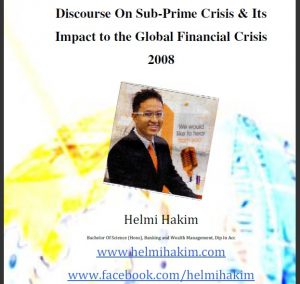
by Helmi Hakim | Jul 7, 2013 | Insurance, Investment, Miscellaneous
Few weeks back, my colleagues and I were invited to the World Islamic Banking Conference, at Pan Pacific, Singapore.
It was an eye opening event for us, as most Islamic finance practitioners, from all over the world conglomerate to discuss, debate and share ideas, on how to further promote the beautiful essence of Islamic Finance to the whole world.
We, financial consultants, from the only insurance cooperative in Singapore, have our fair share of experiences in promoting shariah compliant funds in Singapore, and to meet and listen in to the worthy speakers, from countries like Malaysia, Kuwait, Bahrain, Dubai, is a breath taking experience indeed.



………………………………………………………………………………………………………………………………………….
…………………………………………………………………………………………………………………………………………
If you have read my previous blog post, you will have realised that every single financial catastrophe that had happened, or is currently ongoing, are due to 3 prohibitive elements. Riba (Interest), Gharar (Uncertainty) and Maysir (Gambling).
Allah S.W.T has told us in the Quran, 1400 years ago, through its messenger, Prophet Muhammad (may peace and blessings be upon him), to avoid these elements, in our daily financial activities.
Today, everytime, there is a financial catastrophe, the world looks for a solution. The solution is indeed, Islamic Finance! 🙂
……………………………………………………………………………………………………………………………………..
…………………………………………………………………………………………………………………………………….
I have written a detailed report on the subprime mortgage crisis and you can read the synopsis here. https://helmihakim.com/investment/my-research-on-the-subprime-mortgage-crisis-2008-and-how-it-relates-to-islamic-finance/
In the report, you will understand that the subprime mortgage crisis enveloped due to the 3 elements, as I mentioned above.
……………………………………………………………………………………………………………………………………………
…………………………………………………………………………………………………………………………………………..
Islamic scholars thus developed financial products, that embodies the principles of Islamic finance. No riba, No Maysir, No Gharar… Difference between Islamic finance instruments as compared to its non shariah equivalents is that, Islamic finance advocates profit and loss sharing, prohibits speculative activities, disallows interest bearing loan facilities and its instruments must be assets based.
The substantive discussion, that stands out during the conference was that, if that is the case, why is it difficult to streamline efforts by Muslim countries, across different jurisdictions, to implement such products, that can be consistently, accepted and used across the world population in the first place?
Why, though the idealogy of Islamic Finance, is growing at a rapid rate, it is still comparatively minute, small, as compared to conventional finance counterpart?
Discussions between the established panels shed some lights on the issue. The answer to it is because of the Impossibility To Have Only One Standardised Shariah Ruling.

I have detailed the crisp of the discussion and 2 main reasons why it is impossible to have one standardised shariah ruling in the world, and how we can come with a solution to it.
……………………………………………………………………………………………………………………………
……………………………………………………………………………………………………………………………
Reason 1: 4 Schools Of Thoughts

As most, will have known, there are 4 Islamic school of thoughts, namely, Shafii, Maliki, Hanafi and Hanbali. Different interpretation of the 4 schools of jurisprudence results in a lack of uniformity in specific forms of Islamic principles applied in Muslim countries.
Similar banking procedures and financial instruments may be accepted in one Muslim country and be rejected in another one.
Malaysia, for instance, is considered to be more liberal in its view of shariah compliance, while Saudi Arabia has much stricter rules on what is allowed and what is prohibited.
……………………………………………………………………………………………………………………
Solution No 1: Mutual Respect amongst industry practitioners and promote multi jurisprudence in an Islamic Shariah Board
In the conference, the speakers agreed that 95% of fatwas (religious advice by Islamic scholars) are on the same page. The only difference in opinion is on a meagre 5%. The 5% difference in opinion is not true or false, nor true or bad. It is based on a premise of good or better.
In Islam, differences of opinion is actually acceptable.

There is this authenticated hadith reported by al-Bukhari and Muslim.
During the battle of the Confederates, Prophet Muhammad S.A.W mentioned to his companions to go to this clan, Banu Qurayza’s place, which were a few miles from Al-Madinah and said “No one among you should pray Asar except at Banu Qurayza.”.
When they went, it came to the Asar prayer. One group says, they will stop and pray, and then continue journey. The other group says, no, they will proceed, and pray when they reach Banu Qurayza.
When they reached Banu Qurayza’s place, they asked the prophet, and the prophet did not disagree, did not reject both. He accepted both. (Source:Sahih Bukhari 5:59:445, See Also: Sahih Muslim 19:4374)
…………………………………………………………………………………………………………………………………….
From this hadith, we can see that during prophet’s time, there is such thing as differences in opinion. One group take the explicit, literal meaning, while the other group looks at what is the meaning behind the ruling. The underlying meaning, that the latter group interpreted is that Prophet wanted them to go, and reach Banu Qurayza as soon as possible.
Hence, applying in today’s context, when we talk about shariah, and when there are differences in opinion, we should see the beauty of interpretations, and not bicker over it.
The speakers in the conference agreed that, encouraging mutual respect and ethics of disagreement between scholars and industry practitioners is important, and promoting multi jurisprudence in an Islamic Shariah Board, can be a positive development indeed, in the near future.
………………………………………………………………………………………………………………………..
………………………………………………………………………………………………………………………..
Reason 2: Contextual Difference Due To Time And Place
It cannot be ignored and denied that the shariah ruling may change due to time and place.
“al-hukmu yaduuru ma’a ‘illatihi wujudan wa ‘adaman”.
The hukum or the ruling move from time to time due to several factors.
One of the speakers in the conference narrated his experience sitting in shariah’s council in a bank in Sri Lanka, minority Muslim country and Bank Islam Malaysia, in Muslim majority country. In some issues presented to the shariah council, he has to agree that factors in Sri Lanka has to be taken into consideration in deciding the shariah ruling.
Situations in Malaysia and situation in Sri Lanka is different. Hence, it is difficult, to come out with a similar, identical set of shariah rulings in Malaysia and in Sri Lanka.
When I meet some of my clients in Singapore, they told me that they read from the internet about a lot of different opinions from Islamic scholars, all over the internet. They then get confused to what is permissible and what is not. One Islamic scholar says, you can do this, and the other says, that you can’t. So who should we follow?
…………………………………………………………………………………………………………………………………..
Solution No 2: Understand contextual difference due to time and place
Alhamdulillah, in Singapore, MUIS (Majlis Ugama Islam Singapura) has been proactive in issuing fatwas on finance and estate matters like, cooperative insurance, revocable insurance nomination, CPF nomination and joint tenancy. The fatwas have been helpful to us, financial consultants in Singapore, in our efforts to educate the Muslim population of 600,000 in Singapore, and to our Non Muslim friends.
The religious experts interpretation of the Quran and Hadith, in pertinence to Singapore’s context.
This in fact, has been practice by various shariah scholars.
Imam Shafie, for example, he has 2 different opinions. Al Qawl Qadim and Al Qawl Jadid
His old views of Imam Shafie when he is in Baghdad, and new views of Imam Shafie when he moved to Cairo, Egypt.
That shows the varying concept of shariah and now in modern Islamic Banking and Finance world. Pertinent issues affect the rulings by the shariah scholars….
In the conference, the speakers shared another anology to substantiate understanding contextual difference due to time and place.

For example, as a Muslim, we have to pray 5 times a day.
The dawn prayer (Subuh/Fajar), the midday prayer (Dhuhr) , the mid afternoon prayer (Asr), the sunset prayer (Maghrib), and the night prayer (Isya’).
In the Quran, it does not tell us to pray the Fajar prayer at 5.30am everyday. It can’t, because in Kuala Lumpur, in January, the fajar prayer will be at 5.30am, when it comes towards August, it could be 6am, the time change.
The Quran will tell, in order for us to determine, when we can start your fajar prayer, when it ends, this is the formula.
That is why we can see that we can pray the fajar prayer, anywhere in the world. In UK, it could be 3am in the morning. Certain time of the year, it could be 3am, 4am.
Similarly in Kuala Lumpur or Singapore for itself, the time could change. But the formula is given. In order for us to perform the fajar prayers, this is the starting point and this is the ending point, and throughout the year, we are able to pray, using that formula. It does not say specifically that we must pray at 5am or at 6am. No. If we do that, then it becomes quite difficult.
The point of contention, for that anology is to enlighten us further that Allah S.W.T has given us the formula for everything. It is up to the shariah scholars to exercise their ijtihad. The shariah experts to exercise the ijtihad. Their knowledge to come out with the opinion about certain situation at a certain point of time, at a certain place.
We as commoners, just follow, the fatwas, irshads and religious interpretations of our local Mufti and asatizahs in Singapore.. Alhamdulillah…. There are many more learning points that I garnered during the conference, and I will share bits and pieces, in time to come…. Insya’Allah… 🙂

by Helmi Hakim | May 2, 2013 | Investment, Miscellaneous
When I meet, my non Muslim clients who are learning more about Islamic finance, sometimes they are curious, and they asked me, why Muslims cannot take interest. (riba)
Why, Muslims, cannot include speculative investments, like derivatives etc2, in their investment portfolio? (maysir)
I will normally answer, that God doesn’t allow us and stop at that. Today, I decide to blog about it. 🙂
Prohibition of interest and speculative activities are clearly mentioned in the Quran.
Allah S.W.T said in the glorious Quran, Surah Al Baqarah, Verse 275

“Allah has permitted trade and has forbidden interest”
Charging and earning interest is haram (forbidden) in Islam. Islamic finance advocates profit and risk sharing. If Islamic institutions lend out money, it becomes partners with the borrower in the venture. Profits and loss will be shared according to agreement.
…………………………………………………………………………………………………
…………………………………………………………………………………………………
Islamic finance also prohibits gambling and speculative activities
As stated in Surah Al-Maeda, Verse 90:

“O ye who believe! Intoxicants and gambling, (dedication of) stones, and (divination by) arrows, are an abomination,- of Satan’s handwork: eschew such (abomination), that ye may prosper.”
On the other hand, conventional banking and finance operation, accepts speculative financial instruments like derivatives.
……………………………………………………………………………………………
……………………………………………………………………………………………
When I research about every single financial crisis that has happened in this world, and I went deep to the root of it, I realised that it is always because of interest (riba) and speculation.
Subprime mortgage crisis, Euro Debt Crisis, Asian Financial Crisis, Baring’s Bank case, you name it, most of the financial crisis that have happened in the world were due to interest and speculation.

I have written a 24 page report on the subprime mortgage crisis that happened in the year 2008, and how it lead to the global financial crisis in the year 2009. You can scroll at the end of this blog post, input your email and download it immediately. Its FREE.
……………………………………………………………………………………………….
……………………………………………………………………………………………….
Speaking of subprime mortgage crisis, if we go to the root cause of it, it happened because of speculation and because people cannot afford to pay burgeoning interest from the loans they take. The subprime mortgage crisis happened because of the availability of subprime mortgage.
Subprime loan is a type of mortgage loan, being offered to those who are not qualified to get loans from mainstream lenders. These people are usually low income earners, first time borrowers or people who has a poor credit history.
Under normal circumstances, when people borrowed money from the bank, they were subjected to few criterias before their loan is approved.
They need to have strong credit scores and repayment histories, provide documentation for income and assets, and provide a down payment of 20% or alternatively purchase private mortgage insurance. If these criteria are fulfilled, their loan application is approved.
These groups of people are known as prime borrowers.
…………………………………………………………………………………………………….
……………………………………………………………………………………………………
However, competition amongst banks ensued, coupled with the view of treatment of loans as “assets” in the bank perspective, has lend to the lenience, of now, accepting loans for people who are previously not qualified.
Due to competition amongst banks, they now allow people who are previously not qualified to borrow. They are people whose FICO scores are under 660, defaulted on credit payment in the past 2 years or currently, owe more than half of their annual income in debt.
These people are called subprime borrowers. Their loan mortgages are known as adjustable rate mortgages.
……………………………………………………………………………………………………………………
…………………………………………………………………………………………………………………..
Adjustable rate mortgages have an initial interest rate. During the real estate bubble, many lenders offered mortgage loans with a very low initial interest rate designed to lure borrowers to loan products.
These very low interest rates, referred to as teaser rates, ended up getting a lot of borrowers into trouble. When the initial interest rate period ended, the interest rate and loan payment increased, sometimes drastically. This phenomenon has come to be referred as rate shock.
…………………………………………………………………………..
…………………………………………………………………………..

For example, the monthly payment for a $300,000 mortgage loan amortised over thirty years with an initial interest rate of 5% is $1,610.46.
If, after the initial interest period, the interest rate jumps to 10%, the monthly mortgage payment jumps to $2,632.71.
Thus, lots of borrowers cannot service their monthly mortgage payments, and then default on their payments. With the interest rates rise and housing prices fall, the borrowers do not have enough equity to refinance or sell.
So you can see here that the root cause of it is the adjustable rate mortgage where initially the interest rate is low, but subsequently, it skyrocket.
………………………………………………………………………………………
………………………………………………………………………………………
I will also touch on the speculative nature of human beings, thinking that property prices will always go up, till the property bubble happens. There are simply too many things to be discussed, and I have discussed it extensively in the report below. Key in your name and email below, and you can download it right away.


by Helmi Hakim | May 1, 2013 | Investment
I have written 2 blog posts, sharing with you on how options work. Click the link below to read them again.
1) http://helmihakim.com/investment/m9a-insurance-regulatory-exam-blog-post-no-1/
2) http://helmihakim.com/investment/m9a-insurance-regulatory-exam-blog-post-no-2/
…………………………………………………………………………………………..
……………………………………………………………………………………………
Now, you have a clearer understanding on how option works. In this blog post, I am going to share with you today on 4 most commonly use, option strategies. They are….
1) Covered Call Strategy
2) Protective Put Strategy
3) Bull Straddle (also known as Long Straddle) Strategy
4) Bear Straddle (also known as Short Stradel) Strategy
I have created the diagram below while studying for my finance degree, to sum up and make it as easy as possible to comprehend. ( You can click on the image to view the full image)

1) Covered Call Strategy
You own the stock and you sell call option.
2) Protective Put Strategy

You own the stock and you buy put option.
Example, you own XYZ shares. The share price now is $50/share. You anticipate a bad news announcement, and are afraid that the share price might goes down. So you buy a put option, with a strike price of $50, by paying a small premium. If the share price goes down to $30, its okay, because you have the right to sell it at strike price of $50.
It is like paying premium for term insurance policy. Death or total and permanent disability happens, family gets money. If nothing happen, you just forego the term insurance premium.
3) Bull Straddle Strategy

You buy call and put option at the same strike price and expiration date.
You do this when you expect that there will be a sharp move in stock’s price in either direction, during the life of the options. You profit from the increased votality in the underlying stock’s price.
Example, if you as the investor expects an important court ruling which outcome can be very GOOD or very BAD for the company, you employ a bull straddle strategy.
4) Bear Straddle Strategy

You sell call and put option at the same strike price and expiration date.
You do this when you expect the stock price to remain steady, and don’t move, thus allowing to earn option premium.
………………………………………………………………………………………………………
………………………………………………………………………………………………………
At first, it might be a bit difficult to grasp these 4 option strategies, because we, as financial advisors in Singapore hardly use this derivative instrument. However, it is crucial to understand, as we upgrade ourselves to be a competent financial consultants, to better service our clients.
Stay tuned for my next blog post! 🙂



















